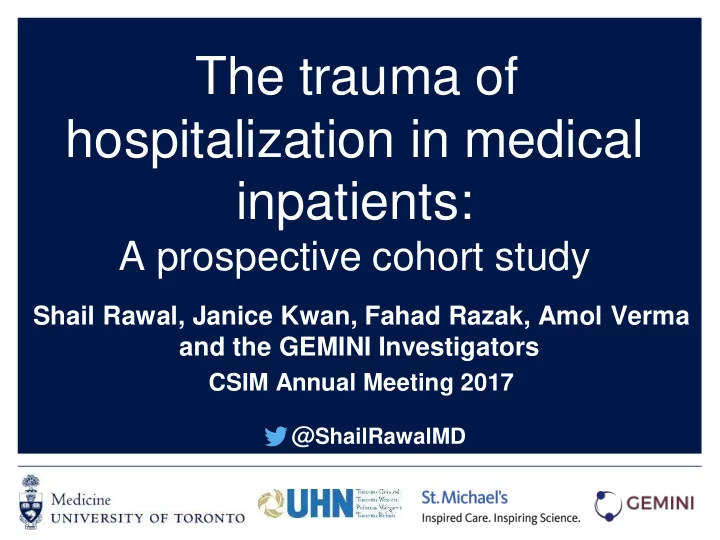

The trauma of hospitalization in medical inpatients: A prospective cohort study Shail Rawal, Janice Kwan, Fahad Razak, Amol Verma and the GEMINI Investigators CSIM Annual Meeting 2017 @ ShailRawalMD
Disclosures • Potential for conflicts: None. • Funders: Canadian Medical Protective Association and the Green Shield Canada Foundation.
• Acute illness • Pain and • Sleep discomfort • Nutrition • Medication • Depersonalization changes • Deconditioning
Trauma of Hospitalization Post-Hospital Syndrome 30-Day ER Visit/ Readmission
Objectives 1) Describe the prevalence of patient- reported disturbances in sleep, nutrition, mobility, and mood in GIM inpatients. 2) Determine whether these disturbances are associated with an increased risk of 30-day ER visit or readmission to hospital.
Methods • St. Michael’s & Toronto Western Hospital • Eligible participants • LOS >48h, English-speaking, capable, discharge home, no ICU admission. • Pre-discharge and post-discharge interview assessing multiple domains using established instruments.
Measures Pre-discharge interview Sleep PROMIS v.1.0 Sleep Disturbance-Short Form 4a Mobility Single-item adapted from eCOG Nutrition Hospital Nutrition Questionnaire Anxiety/Depression Question from EQ5D Outcomes 30-day readmission, ER visit Manually abstracted
Table 1: Baseline Characteristics (N=210) Age, mean (SD) 60.0 (17.0) Sex (%) Female 85 (40.5) Male 125 (59.5) Hospital Site (%) St. Michael’s Hospital 137 (65.2) Toronto Western Hospital 73 (34.8) Length of stay, mean (SD) 8 (7.0) 30-day ER visit (%) 55 (26.2) 30-day Readmission (%) 30 (14.3)
Trauma of Hospitalization 100 % Reporting Disturbance 80 60 40 20 0 Sleep Mobility Nutrition Mood
TOH Score and 30-day 100 ER Visit/Readmission (%) 90 80 70 60 50 40 30 20 10 0 1 2 3 4 Trauma of Hospitalization Score
Multivariate regression of TOH Score and 30-day outcomes Trauma of OR* 95% CI Hospitalization Score Ref. Ref. 1 4.1 1.0-27.5 2 3.0 0.8-20.5 3 6.7 1.5-48.7 4 *Adjusted for age, sex, LOS
Summary 1. The majority of participants in our cohort described disturbances in sleep, mobility, nutrition, and mood. 2. A higher TOH Score was associated with 30- day ER visits and readmissions. 3. Collecting patient-reported outcomes in GIM inpatients is feasible, illuminating, necessary.
Acknowledgements Yishan Guo, Arthi Vasantharoopan, and Matt Riley.
Measures TOH No TOH Average fair or less Good, very good Sleep Confined to bed or Up and about for >50% of Mobility chair for >50% of waking hours, fully active waking hours or confined to bed/chair Nutrition Moderately, severely, Slightly anxious or Anxiety/ extremely anxious or depressed, not anxious or Depressio depressed depressed n
Measures TOH • My sleep quality has been Sleep • My sleep has been refreshing • I have had a problem with my sleep • I have had difficulty falling asleep. During my hospitalization, I was… Mobility Fully active Not fully active but up and about for >50% of waking hours Confined to bed or chair for >50% of waking hours Totally confined to bed or chair When I was eating I was disturbed Nutrition My mealtimes were interrupted by self I missed meals because I was not available when they were served I missed meals because I had to avoid for tests Moderately, severely, extremely anxious or depressed Anxiety/ Depression Short portable mental status questionnaire
Trauma of Hospitalization Trauma of No Trauma of Hospitalization Hospitalization (N=190) (N=20) Sleep 170 ( 81.0) 40 (19.0) Mobility 165 ( 78.6) 45 (21.4) Nutrition 116 ( 55.2) 94 (44.8) 86 ( 41.0) 124 (59.0) Anxiety/Depressio n
Multivariate regression of TOH Score and 30-day outcomes Trauma of OR* 95% CI P Value Hospitalization Score 1 Ref. Ref. Ref. 2 4.08 1.03-27.50 0.08 3 3.03 0.76-20.50 0.17 4 6.70 1.47-48.70 0.03 *Adjusted for age, sex, LOS
Recommend
More recommend